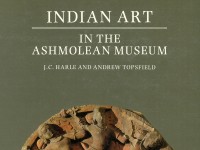Indian Art in the Ashmolean Museum
A catalogue of the Ashmolean’s collection of Indian art by J. C. Harle and Andrew Topsfield (published Oxford, 1987).

Publications online: 143 objects
- Reference URL
Actions
Female head with headdress
-
Literature notes
Only the head remains of what was once a complete female figure in very high relief, probably part of a group. The face with its almond-shaped eyes and fleshy lips has the sensual calm, combined with a certain hard-edged quality, of Mathura Buddhas of c.450 A.D. except that the gaze is not downcast, with the consequent exaggeration of the upper lid. The headdress, on the other hand, belongs to the very end of the Gupta period (c.320-550 A.D.) or even the outset of the post-Gupta, as does the right ear-ring, its “bar” already taking the form of a little baluster. -
Details
- Associated place
-
Asia › India › north India › Uttar Pradesh › Mathura district › Mathura (place of creation)
- Date
-
1st half of the 6th century AD
Gupta Period (AD 320 - 600)
- Material and technique
- red sandstone
- Dimensions
-
16 x 10 x 8.5 cm max. (height x width x depth)
with mount 23.5 x 10 x 8.5 cm max. (height x width x depth)
- Material index
- Technique index
- Object type index
- No. of items
- 1
- Credit line
- Presented by The Honourable Penelope Chetwode, 1961.
- Accession no.
- EA1961.138
-
Further reading
Harle, J. C., and Andrew Topsfield, Indian Art in the Ashmolean Museum (Oxford: Ashmolean Museum, 1987), no. 30 on p. 23, p. 49, illus. p. 23
Harle, J. C., ‘A Gupta Ear-ring’, Leelananda Prematillike, Karthigesu Indrapala, and J. E. van Lohuizen-de Leeuw, eds, Senarat Paranavitana Commemoration Volume, Studies in South Asian Culture, 7 (Leiden: Brill, 1978), illus. pp. 78-80
Ahuja, Naman, ‘Early Indian Art at the Ashmolean Museum - Catalogue in progress’, 2016, no. 116
Location
Objects are sometimes moved to a different location. Our object location data is usually updated on a monthly basis. Contact the Jameel Study Centre if you are planning to visit the museum to see a particular object on display, or would like to arrange an appointment to see an object in our reserve collections.
Galleries
Publications online
-

Indian Art in the Ashmolean Museum
Only the head remains of what was once a complete female figure in very high relief, probably part of a group. The face with its almond-shaped eyes and fleshy lips has the sensual calm, combined with a certain hard-edged quality, of Mathura Buddhas of c.450 A.D. except that the gaze is not downcast, with the consequent exaggeration of the upper lid. The headdress, on the other hand, belongs to the very end of the Gupta period (c.320-550 A.D.) or even the outset of the post-Gupta, as does the right ear-ring, its “bar” already taking the form of a little baluster.
Notice
Object information may not accurately reflect the actual contents of the original publication, since our online objects contain current information held in our collections database. Click on 'buy this publication' to purchase printed versions of our online publications, where available, or contact the Jameel Study Centre to arrange access to books on our collections that are now out of print.
© 2013 University of Oxford - Ashmolean Museum











